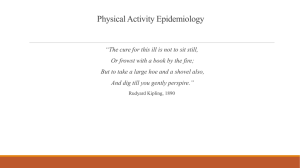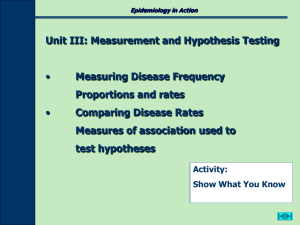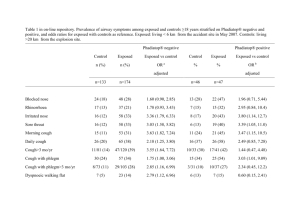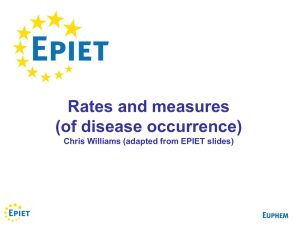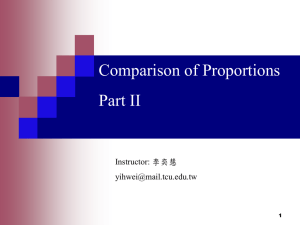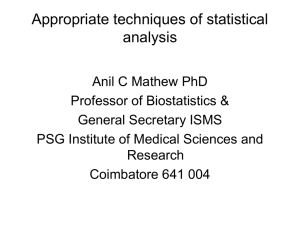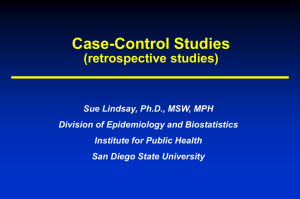a + b - UNC Center for Public Health Preparedness
advertisement
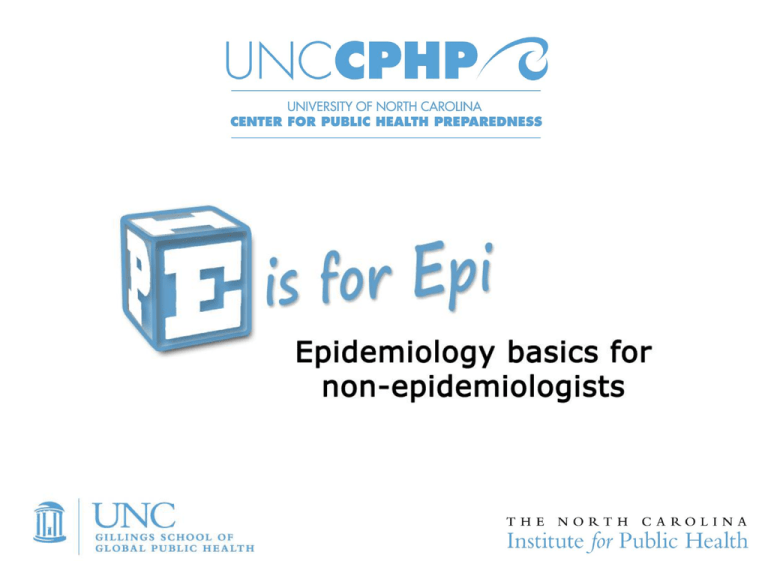
Session 3, Part 3 Data Analysis Basics for Analytic Epidemiology Learning Objectives Session 3, Part 3 • Interpret risk ratios and odds ratios • Describe how a statistical test is used Overview Session 3, Part 3 • Measures of association • Statistical tests Measures of Association Measures of Association • Show the strength of the relationship between an exposure and outcome • Indicate how more or less likely a group is to develop disease as compared to another group • Two widely used measures: – Relative risk (risk ratio, RR) – Odds ratio (OR) 2 x 2 Tables Used to summarize counts of disease and exposure to calculate measures of association Outcome Exposure Yes No Total Yes a b a+b No c d c+d a+c b+d a+b+c+d Total 2 x 2 Tables a = number exposed with outcome b = number exposed without outcome c = number not exposed with outcome d = number not exposed without outcome Exposure ****************************** a + b = total number exposed c + d = total number not exposed a + c = total number with outcome b + d = total number without outcome a + b + c + d = total study population Outcome Yes No Yes a b No c d Relative Risk • Used for cohort study data • Defined as the risk of disease in the exposed group divided by the risk of disease in the nonexposed group Outcome Yes No Yes Exposure No a b c d a a+b Total a+b c+d Risk among the exposed Risk among the unexposed RR = c c+d Relative Risk Example Escherichia coli? Pink hamburger Yes Total Yes 23 No 10 33 No 7 60 67 Total 30 70 100 RR = a / (a + b) c / (c + d) = 23 / 33 7 / 67 = 6.67 Odds Ratio • Used with case-control studies • Population at risk is not known (selected participants by disease status) • Calculate odds instead of risks axd OR = bxc Odds Ratio Example Increased Blood Pressure Caffeine intake “high”? Yes Yes 130 No 115 245 No 120 135 255 Total 250 250 500 OR = axd bxc Total = 130 x 135 115 x 120 = 1.27 Interpreting Risk and Odds Ratios RR or OR RR or OR RR or OR <1 =1 >1 • Exposure associated with decreased risk of outcome • No association between exposure and outcome • Exposure associated with increased risk of outcome Interpretation • RR = 5 – People who were exposed are 5 times more likely to have the outcome when compared with persons who were not exposed • RR = 0.5 – People who were exposed are half as likely to have the outcome when compared with persons who were not exposed • RR = 1 – People who were exposed are no more or less likely to have the outcome when compared to persons who were not exposed Statistical Tests Statistical Tests • Calculations performed to test a hypothesis • Estimate of how likely it is the result is due to chance • Pre-determined threshold for acceptable level of “chance” Tests of Significance • Indicate reliability of the association that was observed • Answers the question “How likely is it that the observed association may be due to chance?” • Two main tests: – 95% Confidence Intervals (CI) – p-values 95% Confidence Interval (CI) • Range of values of the measure of association (RR or OR) that is likely to contain the true RR or OR • Interpreted as 95% “confident” that the true measure of association falls within this interval Interpreting 95% Confidence Intervals • CI range that does not include 1.0 Indicates statistically significant association • CI range below 1 Suggests less risk of the outcome in the exposed population • CI range above 1 Suggests a higher risk of the outcome in the exposed population 95% CI Example: Infertility Exposure Odds Ratio 95% CI Gonorrhea 2.4 1.3 – 4.4 Trichomonas 1.9 1.3 – 2.8 Yeast 1.3 1.0 – 1.7 Other vaginitis 1.7 1.0 – 2.7 Herpes 0.9 0.5 – 1.8 Genital warts 0.4 0.2 – 1.0 Grodstein F, Goldman MB, Cramer DW. Relation of tubal infertility to history of sexually transmitted diseases. Am J Epidemiol. 1993 Mar 1;137(5):577-84 95% CI Example: Infertility Exposure Odds Ratio 95% CI Gonorrhea 2.4 1.3 – 4.4 Trichomonas 1.9 1.3 – 2.8 Yeast 1.3 1.0 – 1.7 Other vaginitis 1.7 1.0 – 2.7 Herpes 0.9 0.5 – 1.8 Genital warts 0.4 0.2 – 1.0 Grodstein F, Goldman MB, Cramer DW. Relation of tubal infertility to history of sexually transmitted diseases. Am J Epidemiol. 1993 Mar 1;137(5):577-84 p-values • A measure of how likely the observed association would occur by chance alone, if there were no true association • Very small p-value (<0.05) – An unlikely result (RR or OR) if there was no true association – Statistically significant • A p-value of 0.05 – Indicates a 5% chance that the RR or OR was observed by chance • Large p-value (>0.05) – A likely result (RR or OR) if there was no true association – Not statistically significant P-value Example Exposure Odds Ratio 95% CI P-value Gonorrhea 2.4 1.3 – 4.4 0.004 Trichomonas 1.9 1.3 – 2.8 0.001 Yeast 1.3 1.0 – 1.7 0.04 Other vaginitis 1.7 1.0 – 2.7 0.04 Herpes 0.9 0.5 – 1.8 0.80 Genital warts 0.4 0.2 – 1.0 0.05 Grodstein F, Goldman MB, Cramer DW. Relation of tubal infertility to history of sexually transmitted diseases. Am J Epidemiol. 1993 Mar 1;137(5):577-84 Summary • Measures of association are calculated to assess the strength of association between an exposure and an outcome in an epidemiologic study • Risk ratios (RR) are the measure of association used for cohort studies • Odds ratios (OR) are the measure of association used for case-control studies • Confidence intervals give a range of values that are likely for a given measure of association • Confidence intervals and p-values can be used to assess statistical significance of a measure of association References and Resources • • • • • Centers for Disease Control and Prevention. Principles of Epidemiology. 3rd ed. Atlanta, Ga: Epidemiology Program Office, Public Health Practice Program Office; 1992. Gordis L. Epidemiology. 2nd ed. Philadelphia, Pa: WB Saunders Company; 2000. Gregg MB, ed. Field Epidemiology. 2nd ed. New York, NY: Oxford University Press; 2002. Hennekens CH, Buring JE. Epidemiology in Medicine. Philadelphia, Pa: Lippincott Williams & Wilkins; 1987. Cohort Studies. ERIC Notebook [serial online]. 1999:1(3). Department of Epidemiology, University of North Carolina at Chapel Hill School of Public Health / Epidemiologic Research & Information Center, Veterans Administration Medical Center. Available at: http://cphp.sph.unc.edu/trainingpackages/ERIC/issue3.htm. Accessed March 1, 2012. References and Resources • • Case-Control Studies. ERIC Notebook [serial online]. 1999:1(5). Department of Epidemiology, University of North Carolina at Chapel Hill School of Public Health / Epidemiologic Research & Information Center, Veterans Administration Medical Center. Available at: http://cphp.sph.unc.edu/trainingpackages/ERIC/issue5.htm. Accessed March 1, 2012. Laboratory Instructor’s Guide: Analytic Study Designs. EPID 168 Lecture Series. Department of Epidemiology, University of North Carolina at Chapel Hill School of Public Health; August 2002. Available at: http://www.epidemiolog.net/epid168/labs/AnalyticStudExerInstGuid2000.pdf . Accessed March 1, 2012.


